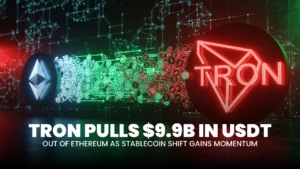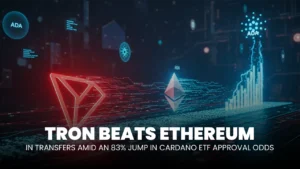TRON’s $500+ Median Transfer Size Marks Grand Shift From Retail to Wall Street Money

TRON’s on-chain activity is attracting renewed attention as the network demonstrates a significant increase in transaction size. According to recent analytics from an online publisher, the median USDT transaction size on TRON has exceeded $500, approaching its historical high of $540.
- Adoption Momentum Backed by Data
- Market Pullback Shapes Context
- Why USDT Transaction Size Matters
- Technical Foundations Support Growth
- Institutional and Strategic Relevance
- TRON Versus Broader Market Dynamics
- Key Data Points Driving the Story
- Conclusion
- Frequently Asked Questions (FAQs)
- Glossary of Key Terms
This represents a jump from levels closer to $480 earlier in the year and suggests a notable transformation in how the network is being used.
The rising transaction size reflects more than casual retail transfers. It points to increased participation from institutions, exchanges, and large players who are routing high-value transactions through TRON’s infrastructure.
The publisher highlighted the trend in a post to X (formerly Twitter):
“Over the past 1.5 years, the average transaction size of USDT on the TRON Network has risen, reflecting growing adoption and institutional use.”
USDT Transfer Volume on TRON Increases: Bigger Players Join!
“Over the past 1.5 years, the average transaction size of USDT on the TRON Network has risen significantly, from $4,273 in June 2023 to $9,718 in December 2024.” – By @JA_Maartun
Full post 👇https://t.co/ZSO9fqDGxj pic.twitter.com/uvJLjYfRQv
— CryptoQuant.com (@cryptoquant_com) December 26, 2024
This simple but telling observation captures the importance of the data. Stablecoin transactions are not only numerous on TRON but are now demonstrably larger, showing that significant value is flowing through the chain.
ALSO READ: TronZap Brings Instant Energy Rentals to Slash USDT Fees as TRON Grows in Stature
Adoption Momentum Backed by Data
Beyond average transaction size, TRON continues to post impressive metrics. Daily on-chain activity consistently records between 7 and 9 million transactions, and cumulative totals have now surpassed 11.1 billion transactions. These figures reflect not just popularity but sustained, repeat use on a massive scale.
Such activity cements TRX’s role as one of the dominant blockchains for stablecoin transfers, particularly USDT. The network’s appeal lies in its speed, low fees, and reliability—all vital when handling transfers worth hundreds of millions of dollars every day.
Market analysts observing the data have noted the shift toward larger transfers. As one crypto analyst put it in a widely shared post:
“Large transactions drive volume dominance on TRX. There is a clear divergence between the size of USDT transactions on TRON and the volumes on other chains.”
📈 Tron’s network stability and transaction records set to soar in 2025.
🔸 The efficiency of the Tron blockchain appears to be improving over time.
Throughout 2025, the percentage of successful transactions has not dropped below 99.3%, a success rate that truly reflects the… pic.twitter.com/a9yewoa4Fp— Darkfost (@Darkfost_Coc) August 9, 2025
The comment reinforces what the numbers already suggest: TRON is no longer just a network of small, retail payments. It is increasingly a backbone for institutional money flow.
Market Pullback Shapes Context
TRON’s growth comes at a time when the broader cryptocurrency market is facing significant headwinds.
- Bitcoin is trading near $115,900, down between 1 and 2 percent in the past 24 hours.
- Ethereum has slipped to $4,230–4,280, reflecting a decline of 3 to 5 percent.
- XRP is hovering close to $3.00, down modestly after testing resistance at $3.09.
- Solana has retreated to about $180, off roughly 6 percent in the week.
- TRON (TRX), by contrast, has remained relatively stable near $0.35–0.36, even posting slight daily gains.
| Cryptocurrency | Approximate Price | 24-Hour Change |
| Bitcoin | $115,000–115,900 | –1% to –2% |
| Ethereum | $4,230–4,280 | –3% to –5% |
| XRP | ~$3.00 | –3% to –4% |
| Solana | ~$180 | –6% weekly |
| TRON (TRX) | ~$0.35–0.36 | Slight gains |
The broader declines stem partly from macroeconomic uncertainty. Traders are bracing for the US Federal Reserve’s upcoming policy signals, leading to reduced appetite for risk assets across equities and crypto. In this environment, TRON’s stable network metrics stand out.
Why USDT Transaction Size Matters
The increase in median transaction size on TRON is not simply a statistical curiosity. It carries strategic implications for the future of stablecoin use and blockchain infrastructure.
Larger transactions imply that more institutional actors are relying on TRX to move money. Exchanges, trading firms, and payment processors often shift funds in bulk.
If those transfers are happening on TRON, the network is playing a critical role in the plumbing of the crypto economy.
This type of activity also builds trust in the chain itself. As more high-value transfers settle successfully, confidence grows that TRON can reliably handle the scale and stakes of modern finance.
Technical Foundations Support Growth
TRON’s ability to manage such growth rests on its consensus mechanism, Delegated Proof of Stake. Unlike Proof of Work systems that depend on computational mining, or simple Proof of Stake systems that allow validators to secure the network directly based on token holdings, DPoS takes a different approach.
In DPoS, token holders vote for a fixed set of validators, called Super Representatives, who are responsible for verifying transactions and producing blocks. This structure allows for very high throughput, extremely low transaction fees, and strong scalability.
The benefits are visible in TRON’s performance. Even as the average transaction size climbs, the network processes millions of transactions per day without congestion or dramatic fee spikes. For institutions moving large sums, predictability and low friction are as important as security and TRON’s model delivers both.
Institutional and Strategic Relevance
As TRON absorbs more institutional-level transactions, its role in the global stablecoin infrastructure becomes more pronounced. The majority of USDT in circulation now lives on TRON, and the chain’s growth suggests that dominance is not likely to fade soon.
Delegated Proof of Stake helps explain why. The model allows TRON to prioritize speed and scale while maintaining decentralized governance through its elected validator system. For institutional participants that need dependable settlement, TRON’s DPoS consensus ensures both resilience and capacity.
Other networks, including Ethereum and Solana, continue to carry significant portions of stablecoin volume. But the median transaction size data shows that TRON is not just competing, it is becoming the preferred choice for large, high-value transfers.
TRON Versus Broader Market Dynamics
While price movements often dominate crypto headlines, network activity tells a deeper story. Bitcoin and Ethereum may define market capitalization, but TRON’s steady transaction volume and climbing transaction size underscore its infrastructural significance.
Even as the overall market contracts, TRON’s usage metrics expand. That divergence between price performance and network fundamentals is significant. It suggests that TRX’s role in day-to-day financial transfers is strengthening independently of speculative cycles.
This differentiation could prove pivotal in the long run. If adoption metrics continue to rise, TRX will have demonstrated resilience not just in market hype phases but also in periods of consolidation and downturns.
Key Data Points Driving the Story
- Median USDT transaction size on TRX has risen above $500, close to the network’s historical high.
- Daily throughput averages 7–9 million transactions, maintaining strong network usage.
- Total lifetime transactions have crossed 11.1 billion, highlighting sustained adoption.
- In the same period, Bitcoin and Ethereum prices fell, but TRX held firm around $0.35.
- TRON’s Delegated Proof of Stake system underpins its capacity to manage high-value flows efficiently.
Each of these data points tells the same story from a different angle: TRX’s role as a stable, reliable infrastructure layer is deepening, even while broader crypto valuations fluctuate.
Conclusion
TRON is steadily emerging as one of the most important backbones of the crypto economy. Rising median transaction sizes, coupled with strong daily activity and total adoption milestones, demonstrate that both retail and institutional players are choosing TRX as a settlement layer for stablecoins.
At the center of this growth is Delegated Proof of Stake, which provides the network with speed, scalability, and reliability. As more large transfers settle on TRX, its reputation as the stablecoin highway of choice only grows stronger.
While the broader market retrenches, TRON’s steady fundamentals highlight its growing importance in global crypto infrastructure. For both institutions and individuals, TRX represents a network that can handle scale, speed, and value all at once.
Frequently Asked Questions (FAQs)
- What does the rising USDT transaction size on TRX indicate?
It suggests that institutional and large-scale players are increasingly using TRX for high-value stablecoin transfers. - How does TRX’s Delegated Proof of Stake help its growth?
DPoS allows TRX to process millions of transactions per day at low cost, making it reliable for large transfers without congestion. - How are other top cryptocurrencies performing?
Bitcoin trades near $115,900, Ethereum near $4,250, XRP at $3.00, and Solana around $180—all lower. TRX remains stable near $0.35. - Is TRX’s growth speculative or based on real use?
It is based on measurable adoption data, such as rising transaction size, total transactions exceeding 11 billion, and steady daily throughput. - Why is USDT activity important to watch?
As the largest stablecoin, USDT underpins global crypto liquidity. Growth in its use on TRX shows where the market is settling most value.
Glossary of Key Terms
- USDT: A widely used stablecoin pegged to the U.S. dollar.
- Median transaction size: The middle value of all transaction amounts, showing the typical transfer size.
- Delegated Proof of Stake (DPoS): A consensus model where stakeholders elect validators to secure the network, enabling high throughput and low fees.
- Validator: A trusted network participant responsible for verifying transactions.
- Throughput: The total number of transactions a blockchain can process in a given time.
- Stablecoin infrastructure: The set of blockchain networks and services that support the use of stablecoins like USDT.




